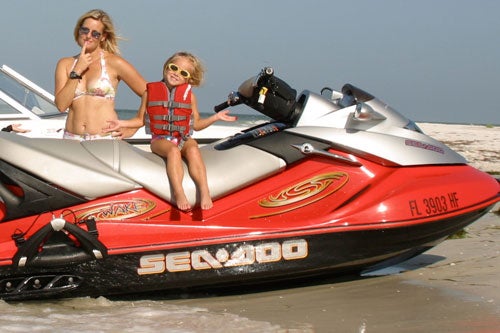How To Ride a PWC with a Child
Safely share the joys of PWC with your children
If you’re a personal watercraft-riding parent, you’ve probably already faced the dilemma of when to allow your child to come along for a spin. If they’re still toddlers, you may have already outfitted them in a PFD, wedged them between you and your spouse, and taken them for a relatively tame ride on the water.
But what do you really need to know about safe riding with young children?
“Safe boating with children can be great fun and a fantastic adventure for all,” suggests Cathy Ferriss, a certified YMCA Aquatic Instructor. “It does, however, require a little thought, planning, and preparation — but what doesn’t when you include kids!”
Obviously, safe boating of any kind with children starts with a properly fitted PFD. Try different styles on for comfort, but verify that the vest is Coast Guard-approved and that it is the right one for your child’s weight. That info will be stamped on the inside of the vest. “The life jacket should go on the child before they ever leave the house, or get out of the car at the launch ramp,” says Ferriss. “Water is shiny and it moves. You will have your hands full of supplies, and that is when your child will go straight for the water.”
 Taking your child out for a ride on a PWC can be fun for everybody.
Taking your child out for a ride on a PWC can be fun for everybody.Young children (typically under 50 pounds and four years of age), are best served with a Type II PFD, recognized by the “pillow” behind the child’s head. Why the pillow? It’s easy to teach children to lean their heads back against it; that will keep their face upright, offer more stability, and allow the child to stay on their back and relaxed. This type of PFD also features a handle, which a rescuer can use to tow a child to safety while remaining safely out of reach of flailing hands. Before you climb aboard, let your child get used to the jacket, both in and out of the water. Vests should fit snugly, giving no more than three inches when lifted at the shoulders, and with the crotch strap securely fastened.
When to start? The Coast Guard recommends leaving infants at the dock until they are at least 18 pounds (typically shy of one year). Common sense dictates that a child should not be brought aboard any type of boat until a PFD fits them properly, and will stay secure. USCG statistics show over half of the boating deaths of children under 13 are a result of drowning, most of which could have been prevented had the child been wearing a properly fitting PFD.
As to where to put a young child, opt for the middle between two responsible adults. Kids love to ride in front, but there’s too much of a chance that their face could impact the handlebars should you slow abruptly or encounter rough water. Keep speeds slow and controlled, gradually increasing the thrill of the ride with age. Avoid any crazy maneuvers; it’s far too easy for a child to be thrown from the craft. Slow and controlled is the way to go.
In the event your child does go overboard, practice your response. Assuming there are at least two adults on board a three-passenger PWC (avoid solo parent duty on a PWC – a driver’s attention needs to be focused on the water, not on a child), have the passenger take control of the situation. That person should tell the driver to immediately kill the engine and stay aboard, survey the scene for traffic and safety hazards, then enter the water. Swim to the child, keeping the head above water to maintain constant sight. In fact, one person should be assigned to keep tabs on a young child at all times while on board, no matter what size the vessel.
Related Reading
How to Camp Via Personal Watercraft
PWC 101: Safety
PWC Rules of the Road
Things to Consider Before Letting a Friend Ride Your PWC
Get PersonalWatercraft.com in your Inbox!
Like PersonalWatercraft.com on Facebook
Comments
Most Popular

2025 Yamaha JetBlaster PRO 2-Up Review

2024 Kawasaki Jet Ski STX 160X Review

Remembering the Sea-Doo XP

Whatever Happened to the Wetbike?

2025 Yamaha JetBlaster Review












 Your Privacy Choices
Your Privacy Choices